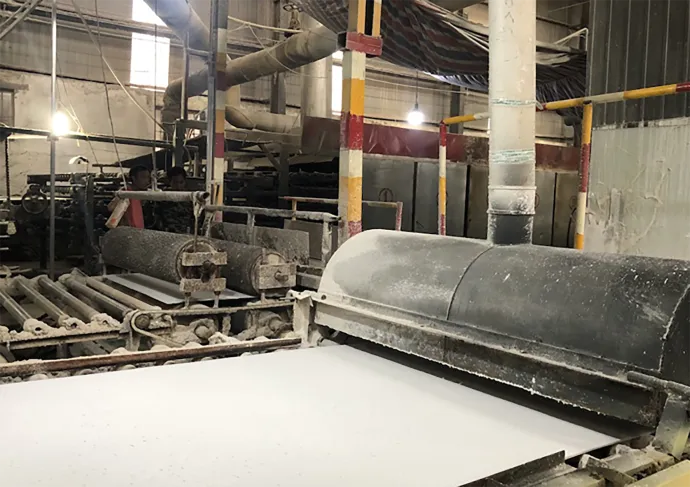Nov . 17, 2024 09:10 Back to list
gypsum board vs pvc ceiling
Gypsum Board vs. PVC Ceiling A Comprehensive Comparison
When it comes to interior design and construction, choosing the right ceiling material can significantly impact both aesthetics and functionality. Two popular options on the market today are gypsum board and PVC (polyvinyl chloride) ceilings. Each material has its unique advantages and drawbacks, and understanding these differences is crucial for making an informed decision for your home or office space.
Gypsum Board A Classic Choice
Gypsum board, commonly referred to as drywall or plasterboard, has been a staple in construction for decades. It consists of a core made of gypsum, sandwiched between two sheets of heavy paper, creating a versatile and durable material. One of the most significant advantages of gypsum board is its fire-resistant properties. Gypsum contains water molecules that are released when heated, providing a crucial barrier against flames and reducing the risk of fire spreading.
In addition to its fire resistance, gypsum board offers excellent sound insulation. The dense structure of the material helps to absorb sound, making it an ideal choice for residential buildings, offices, and multi-family units where privacy is a concern. Furthermore, gypsum board can be easily painted or finished, allowing for a wide range of design options.
However, gypsum board does have limitations. It is susceptible to moisture, which can lead to mold growth and degradation in humid environments, such as bathrooms or kitchens. Additionally, once installed, repairing damaged gypsum board can be time-consuming, as it often requires patching and repainting.
PVC Ceiling A Modern Solution
On the other hand, PVC ceilings have gained popularity as a modern alternative to traditional materials. Made from plastic, PVC ceilings are lightweight, waterproof, and highly resistant to moisture, making them an excellent choice for areas prone to humidity. This attribute is particularly beneficial in bathrooms, kitchens, and basements, where water exposure is common.
gypsum board vs pvc ceiling

Another significant advantage of PVC ceilings is their low maintenance requirements. Unlike gypsum board, which may need repainting and repairs over time, PVC ceilings can be easily cleaned with a damp cloth, and they do not require additional finishing. They are available in various styles, colors, and textures, enabling homeowners to create personalized aesthetics without extensive renovations.
Moreover, PVC ceilings offer good sound insulation, although they may not be as effective as gypsum boards in this regard. Their lightweight nature makes installation quick and straightforward, reducing labor costs and time associated with the project.
However, PVC ceilings do pose some environmental concerns. As a plastic product, PVC is not biodegradable and can be challenging to recycle. Furthermore, it can be less durable than gypsum board in the long term; while it is resistant to moisture and stains, PVC can become brittle or discolored over time, particularly when exposed to sunlight for extended periods.
Cost Comparison
When considering which option is more cost-effective, both gypsum board and PVC ceilings can vary significantly in price depending on quality and design. Gypsum board is typically less expensive upfront, but the costs can increase with additional materials required for installation and maintenance. Conversely, while PVC ceilings may have a higher initial price, their durability and low maintenance may lead to savings in the long run.
Conclusion
In summary, the choice between gypsum board and PVC ceilings largely depends on the specific requirements of the space and personal preferences. Gypsum board is an excellent option for its fire resistance, sound insulation, and aesthetic versatility, making it ideal for many residential and commercial applications. However, if you are looking for a lightweight, waterproof solution with minimal maintenance, PVC ceilings may be the better choice, especially in areas prone to moisture.
Ultimately, considering factors such as installation costs, maintenance, aesthetic preference, and environmental impact will guide you in making the right decision for your ceiling needs. Whether you choose gypsum board or PVC, both materials offer unique benefits that can enhance the functionality and appearance of your space.
-
Durable Ceiling T Grid Systems | Easy InstallationNewsAug.29,2025
-
PVC Gypsum Ceiling: Durable, Laminated Tiles for Modern SpacesNewsAug.28,2025
-
Pvc Gypsum Ceiling Is DurableNewsAug.21,2025
-
Mineral Fiber Board Is DurableNewsAug.21,2025
-
Ceiling Tile Clip Reusable DesignNewsAug.21,2025
-
Ceiling T Grid Modular DesignNewsAug.21,2025







